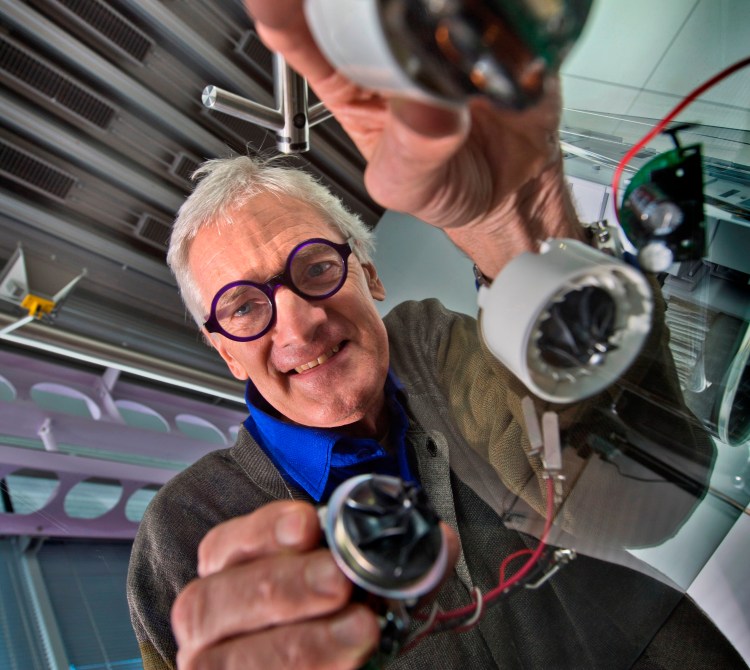Sir James Dyson sold the first dual-cyclone vacuum in 1993. His main innovation had to do with how the dirt and dust particles would collect in a centrifugal cyclone. If you use a Dyson vacuum today, you know you don’t have to replace the dust bag. You just grab the cyclone chamber and dump the contents into the garbage. Not only does the vacuum suck up more dirt and grime, it’s easier to use because you don’t have to replace a bag (although you do have to clean the filters). Since 1993, Dyson vacuums have become a household name. More importantly, almost all vacuums these days use a similar cyclone chamber to clean your carpet.
Last week, the company known for sucking up dust announced plans to address how cars today release carbon emissions. Dyson the company is working on an electric car and has already hired 400 engineers to build the technology. Sir James says the company will invest $2.7 billion in an EV that will launch in or around the year 2020.
While there aren’t too many details about how this will all work, there’s nothing quite like the hubris of an inventor who decides to take on a new challenge. The company has already developed an amazing bladeless fan, called the Air Multiplier, that can cool or heat an entire room. (A commercial product dries your hands in the bathroom.) This is not a company that takes things lightly. Its vacuums changed the industry; its fans actually work.
But what about an electric car?
June 5th: The AI Audit in NYC
Join us next week in NYC to engage with top executive leaders, delving into strategies for auditing AI models to ensure fairness, optimal performance, and ethical compliance across diverse organizations. Secure your attendance for this exclusive invite-only event.
In my view, this is a much more complex challenge, not because of the technology but due to how the current automotive industry works. I’ve long asserted that Tesla is an innovative company and has many smart ideas, but the truth is that Ford sells more trucks in one trim level in a month than Tesla likely sells in a year. (It’s hard to know the exact figures for Tesla because most of its “sales” right now are actually preorders for the Model 3.)
Dyson has an uphill climb. Tesla attracted attention for its Model S sedan and how some versions are quite sporty. The range can hit 300 miles, which is about the sweet spot for an EV owner worried about how far they can drive on one charge. There are Tesla charging stations all over the U.S. now, including one that’s just up the road from my house. Yet, on a typical drive in Minneapolis on any given workday, I’ll see maybe one Model S. Meanwhile, there are hundreds of GM, Ford, and Fiat-Chrysler cars and trucks. It’s not just domination in the market. It’s a total stranglehold on the supply chain, market share, driver confidence, and everything in between. There are several dozen “normal” car dealerships in my city. There is one Tesla store.
So how will Dyson succeed? One of the keys will have to do with the range of the vehicle. If Sir James and crew can somehow figure out how to increase the range dramatically — say, up to 500 miles or more — then it won’t matter whether there are many Dyson charging stations around. If the car is zippy and looks cool, that’s great, but Dyson is known for innovative technology. To make an electric that doesn’t suck, it will need to focus on range.
And there will be an incredible amount of competition by then, beyond the Model S and the Chevy Bolt EV. Nissan recently improved the range on the Leaf electric, and Dyson should definitely pay attention to what Honda is doing — especially since that company is also quite diverse and makes a portable battery pack and many products beyond cars.
But the main issue facing Dyson is market perception. Let’s say the Dyson electric does manage to drive much farther than other EVs, does offer some unique features, and looks like something you’d want to drive and not a car-shaped vacuum cleaner. The average car buyer is loyal to GM, Ford, or Chrysler. Dyson is not known for electric cars, so the vehicle will need to offer something extraordinary even beyond extended range and the technology.
Here’s what could work: a low price.
If Dyson can somehow design a lower-cost EV with excellent range, that could cause enough market differentiation. Let’s say it somehow offers a Dyson EV in 2020 that costs $20,000. Suddenly, drivers will forget all about their brand loyalty. They’ll quickly get past the fact that the car is brand new and untested. They’ll become curious about the new innovations.
It’s doubtful — a high-end Dyson vacuum still costs $400 or so. If the EV costs $20,000, it will be tempting for the average consumer deciding between that and a Chevy Cruze. In fact, I’ll go on record here — if the company does make a low-cost electric, I might just jump on board myself.

